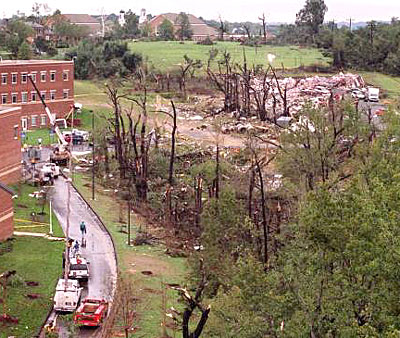COLLEGE PARK – University of Maryland police defended their decision Friday to send out three urgent alerts saying that a tornado could hit the campus within minutes, despite the fact that the National Weather Service had not issued a tornado warning for the area.
Thunderstorms rolled over the campus Thursday night when university police sent out an email at 6:28 p.m. indicating that a “tornado is forecast to strike campus within the next 13 minutes.” A follow-up at 6:52 p.m. said a tornado could touch down within ten minutes. A third message at 6:59 p.m. said a tornado could strike within three to four minutes.
Video by Brendan Ponton/CNS-TV
The sky darkened. Emergency sirens blared. Rain fell as panicked students, staff and faculty rushed to take cover. But no tornado appeared.
The National Weather Service had issued a tornado watch for the Washington metro area, indicating favorable conditions for tornado development. But it had not issued a tornado warning, indicating an imminent strike.
University of Maryland police said they sent out the messages based on warnings from AccuWeather Enterprise Solutions, which supplies the university with detailed forecasts of severe weather in the area. AccuWeather forecasts found a high probability that a tornado could hit the area Thursday night.
Last month marked the 10-year anniversary of the death of two University of Maryland students in a tornado that hit College Park. Fearing a repeat of that tragedy, University Police spokesman Capt. Marc Limansky said they would have been remiss in not sending the warning messages based on AccuWeather’s information.

“If [AccuWeather] sends out an alert, you can lay dollars to donuts there’s going to be a storm here,” Limansky said, adding that he remained confident in the service’s predictions.
Eric Wilhelm, a senior meteorologist for AccuWeather, said there was real reason to believe that a tornado could have struck College Park Thursday evening. Wilhelm cited low humidity, a moist air mass and wind sheer as indicators that a tornado could have formed.
Wind sheer occurs when wind direction varies at different levels of the atmosphere. On Thursday night, winds were coming out of the Southeast in the lower level of the atmosphere and out of the West in the higher atmospheric levels. That is a recipe for dangerous wind rotations, Wilhelm said.
Area meteorologists and several news outlets questioned why the university would send out emergency weather alerts to students when the National Weather Service had not issued a warning.
“Only the National Weather Service can issue watches and warnings. Period,” Steve Rudin, a broadcast meteorologist for WJLA/ABC7, wrote on Twitter Thursday.
Some students on campus also questioned the decision. “I think it was a little bit overkill to use the whole siren system and everything when nobody else really thought the storm was that dangerous,” said Jessica Rothmeier, a sophomore civil engineering student at the university.
At the time when the two students were killed by the tornado in 2001, there was no university-wide emergency system in place, Limansky said. Some students said they were grateful for the warnings, even if no tornado arrived.
“It’s always better to be over-prepared than under,” said Chris Woodruff, a sophomore civil engineering student. “If there had been anything going wrong, we would have been ready, which was nice.”


You must be logged in to post a comment.